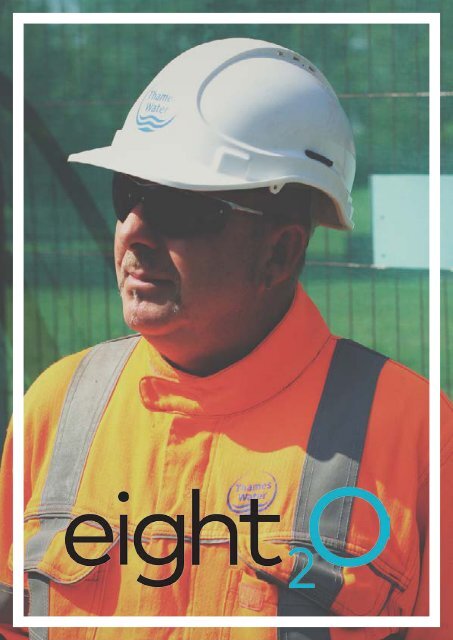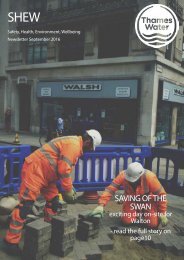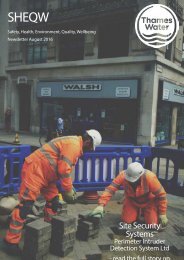JULY EDITION
Create successful ePaper yourself
Turn your PDF publications into a flip-book with our unique Google optimized e-Paper software.
4<br />
WHAT WE COULD DO<br />
BETTER<br />
Requirements for site<br />
notice boards<br />
6<br />
YOUNG PEOPLE<br />
How we can protect young<br />
people on our works<br />
7<br />
IN THE COURTS<br />
Latest environmental<br />
prosecution<br />
8<br />
TOPIC OF THE MONTH<br />
Working near watercourses<br />
10<br />
HAND ARM VIBRATION<br />
How to protect yourself<br />
11<br />
CONTACT DERMATITIS<br />
How to prevent this<br />
CONTENTS<br />
12<br />
IN THE SPOTLIGHT<br />
Basingstoke CHP<br />
14 16<br />
CA TRAINING<br />
Silt buster training<br />
SMB REPORTING<br />
Latest SHE statistics<br />
18<br />
SAFETY ALERTS<br />
Latest safety alerts for<br />
dissemination
SHE NOTICE-BOARD REQUIREMENTS<br />
We need to ensure that the relevant information<br />
is displayed in our compounds and welfare<br />
cabins, to ensure the right message is recieved<br />
by all personnel.<br />
We understand that space can be limited and<br />
so we have put together a guide for different<br />
types of sites.<br />
Templates are available - speak to the SHE<br />
Team to get this<br />
WHAT<br />
WE<br />
COULD<br />
DO<br />
BETTER<br />
MANDATORY REQUIREMENTS<br />
• CSIM Escalation Chart<br />
• IEMP Poster (if applicable )<br />
• Site Map (with environmental constraints)<br />
• Map showing directions to nearest hospital<br />
• First Aider details<br />
• F10<br />
• Eight2¬O H&S Policy<br />
• Eight2O Environment Policy<br />
• Eight2O Sustainability Policy/ Poster<br />
• HSE Poster<br />
NOTE - smaller schemes with small cabins or no welfare do not need to display this, but must have<br />
access to this<br />
Other things to consider<br />
• Communication updates/ newsletter<br />
• Recent Toolbox Talks<br />
• Insurance certificates<br />
• Environmental Posters (search ENV POS on twexnet)<br />
• TOCOP (if required)<br />
• Top 5 hazards
YOUNG<br />
PEOPLE<br />
ON OUR<br />
WORKS<br />
eight2O have a growing number of ‘Young Person’s’ (over school<br />
leaving age, but not yet 18) working across its sites. We must<br />
ensure that we are managing their site involvement and protect<br />
them from potential hazards.<br />
It is generally accepted that a ‘Young Person’ will not have the<br />
same level of hazard awareness as others in your team. Therefore,<br />
the following must be considered before putting them to work;<br />
• The layout of the workplace;<br />
• How they will handle work equipment;<br />
• How the work and processes are organised;<br />
• The extent of health and safety training needed/recieved<br />
• Risks from particular agents, processes and work.<br />
Young Persons: An Assessment of Risk<br />
A risk assessment covering all activities must be carried<br />
out before allowing a young person to work on your site.<br />
Once complete this must be reviewed by your H&S Advisor.<br />
When completing this, consider;<br />
• The inexperience and immaturity of the young person;<br />
• Their lack of awareness of risk;<br />
• The nature and exposure to COSHH;<br />
• The range and use of tools and equipment<br />
• Any health and safety training e.g. site induction and TBT’s<br />
• The tasks they are expected to carry out.<br />
For more information speak to your H&S Advisor and make sure<br />
they are aware of any ‘young persons’ starting on site.<br />
IN THE<br />
COURTS<br />
Record<br />
breaking fine<br />
£1 million<br />
A sewage treatment company has been fined for failing to prevent<br />
incidents occurring, after 6 million litres of sewage spilled into the River<br />
Ouse.<br />
The works require 3 pumps to cope with the volume of sewage and a<br />
backup in case these fail. For 5 months in 2013 the backup pump was out<br />
of action. As a result, in August 2013, when one of the pumps failed, the<br />
remaining pumps could not support the volumes.<br />
The Environment Agency followed the incident up in 2014 and<br />
discovered that again the backup pump was out of action and had not<br />
been replaced. This led to the courts fining the company for failing to<br />
implement pollution prevention measures.
TOPIC OF THE<br />
MONTH:<br />
Working near<br />
watercourses<br />
This includes rivers, lakes, ponds, reservoirs, canals, drainage ditches, estuaries<br />
and coastal waters. If we are working near these, we have the potential to cause<br />
pollution, which could lead to prosecution and clean-up costs.<br />
How to manage working near a watercourse<br />
• Prevent water contamination e.g. cover excavations during rainfall, ensure roads<br />
are kept clean;<br />
• Store materials, machinery and waste at least 10m’s away from any watercourse;<br />
• Ensure containment processes and spill response measures are in place – spill<br />
kits should be located in any high risk area (e.g. storage areas, working areas, near<br />
machinery etc.)<br />
• Refuelling should occur at least 10m away from the watercourse and drip trays<br />
should be used;<br />
• Ensure daily briefings and RAMS include mitigation measures;<br />
• DO NOT wash anything down into a watercourse or surface water drain without<br />
permission from your Environmental Advisor<br />
Case Study 1: Hornsey Emergency Scheme<br />
Following a recent main burst in Hornsey, SMBJV were on site to fix the pipe and reinstate<br />
the area around the burst.<br />
The burst sent clean water flowing across a grassed area, along a footpath and into the<br />
adjacent New River, causing an area of the river bank to collapse.<br />
Work to repair the bank will take place later this year. This work will involve working in the<br />
river and so all appropriate controls will be followed.<br />
What the teams did;<br />
• The work area was cordoned off<br />
• All plant and material were kept at least 10m from the edge or the river<br />
• TBT on working near watercourses was given<br />
• All liquids and plant when not in use, were stored away from the river to prevent any<br />
contamination from spillages.<br />
REMEMBER – Your Environmental Advisor is there is provide advice and<br />
guidance on how to mitigate these risks.
HAND ARM VIBRATION SYNDROME<br />
Hand Arm Vibration Syndrome (referred to as HAVS) is caused by the over exposure to vibration in the<br />
hands, fingers, wrists and arms.<br />
If you use hand-held power tools, be aware that over-use can affect your ability to work and enjoy a normal<br />
home and social life.<br />
What is it?<br />
What are the symptoms?<br />
HAVS can occur where the nerves, blood<br />
vessels and/or joints are damaged by vibration.<br />
Whilst uncommon, symptoms can occur in the<br />
short or long term. Early detection is crucial<br />
and if ignored can become more serious and<br />
in some cases permanent.<br />
You may be more at risk if:<br />
• You regularly operate hammer action tools<br />
(such as breakers, drills, needle guns etc.) for<br />
more than about 15 minutes per day<br />
• You operate some rotary and other action<br />
tools for more than about an hour per day<br />
• You smoke<br />
• You grip vibrating tools too tight<br />
• Pins and needles<br />
• Loss of sense of touch<br />
• Difficulty in everyday tasks (e.g. tying shoelace)<br />
• Tips of your fingers going white, particularly in cold<br />
and wet conditions, and becoming red and painful on<br />
recovery<br />
If exposure continues there may be:<br />
• Loss of manual dexterity making it difficult to pick up<br />
small items<br />
• Severe pain and numbness<br />
• Symptoms which appear more frequently and spread<br />
to more of the fingers<br />
What can I do?<br />
• Stay aware and follow good practice<br />
• Don’t exceed the maximum safe working times<br />
• Swap between tasks that involve vibration and those<br />
that don’t<br />
• Massage your hands and fingers<br />
• Keep your hands warm in cold weather<br />
• Make sure your protective gloves fit properly.<br />
If you are worried that you are suffering from the symptoms of HAVS, it is important that you discuss this at<br />
the earliest opportunity with your GP or Healthcare provider.<br />
PREVENTING CONTACT DERMATITIS<br />
Contact dermatitis occurs when your skin reacts to a particular substance. This can be either;<br />
an irritant – a substance that damages the skin<br />
an allergen – a substance that can cause the body to react abnormally<br />
Common irritants include:<br />
• soaps and detergents<br />
• antiseptics and antibacterials<br />
• perfumes and preservatives in toiletries<br />
• solvents<br />
• oils used in machines<br />
• disinfectants<br />
Avoid contact where possible, but if this is not;<br />
• acids and alkalis<br />
• cement<br />
• powders, dust and soil<br />
• water – especially chlorinated water<br />
• many plants<br />
1. Clean your skin<br />
Rinse the affected skin with warm water and a soap substitute (such as an emollient – see below).<br />
2. Use protective clothing (especially gloves)<br />
You may find it useful to wear cotton gloves underneath rubber gloves, if the rubber irritates you.<br />
Take your gloves off every now and again, as sweating can make any symptoms worse.<br />
3. Change products if you show any signs of dermatitis<br />
Check products ingredients to make sure it does not contain any irritants or allergens.<br />
4. Use emollients to keep your skin hydrated and protect it<br />
This is better than bar or liquid soaps which can dry out your skin. This is particularly important if<br />
you need to wash your hands frequently at work.<br />
5. Use of barrier creams to create a barrier between you and the irritant<br />
6. Apply after-work creams to reduce frequency and symptom severity
Works located next to drainage channel leading to the River Lodden -<br />
On returning to site after the Christmas break the site was found to be flooded. This washed away<br />
temporary roads and turned the site into a mud bath.<br />
To cope with the heavy rainfall, the team have installed a french drain which filters the water through to<br />
one of the on-site structures that is acting as a holding tank. It is then pumped to a settlement tank and<br />
discharged to an area of land agreed with Thames Water (via a TWOSA).<br />
Management techniques<br />
• Water sampling - to ensure minimal silt accumulation<br />
• RAMS - specific to dewatering<br />
• Recorded using the Permit to Pump form - the site records pictures of settled out sample bottles<br />
and test the pH.<br />
Traffic Management<br />
• Due to space constraints, efficient traffic management has been imperative. The use of a one way<br />
system for deliveries to site, as well as clear pedestrian walkways and barriers have been effective<br />
in reducing the risk moving vehicles pose to site personnel.<br />
• Banksmen are also used to negate any potential problems caused during the operation of<br />
excavators, dumpers and rollers.<br />
No Injuries on site in over 67,800 man hours<br />
IN THE SPOTLIGHT<br />
BASINGSTOKE CHP<br />
The Basingstoke Thermal<br />
Hydrolysis Plant (THP) that<br />
includes additional digester<br />
capacity and CHP generation<br />
is part of the AMP6 strategy to<br />
eliminate lime sludge treatment.<br />
The end goal is that after start-up,<br />
the THP and generation system will<br />
be self-sufficient. Surplus power<br />
generated, will be consumed by the<br />
rest of the works and any surplus<br />
above this will be exported to grid.
In June, a selection of CAJV’s SHE team, Site<br />
Managers and Foremen undertook a training<br />
course on silt management delivered by Siltbuster.<br />
This training was arranged due to a number of<br />
recent silt related incidents, in an effort to increase<br />
awareness and to ensure the implementation of<br />
best practice.<br />
The day was well-received by all attendees and<br />
feedback is currently being gathered on the training<br />
to enable the environmental team to produce<br />
some targeted training for site teams on this topic.<br />
If you would like to arrange this training<br />
for yourself or your site teams, inform your<br />
Environmental Advisor.<br />
Day 1<br />
• Silt pollution legislation and prosecution case studies<br />
• Disposal of water and filtration techniques of silt laden waters<br />
• Permits and Consents<br />
• Erosion control<br />
• Practical solutions for silt removal<br />
• Methods for the treatment of Concrete Wash Water<br />
• Practical experiments to separate silt particles from silty water.<br />
SILT BUSTER TRAINING<br />
Day 2<br />
• How to estimate groundwater flows<br />
and treat hydrocarbons and dissolved<br />
metals.<br />
• Importance that silt and water<br />
pollution management is given early<br />
consideration at the design stage,<br />
including;<br />
- site set up to include water attenuation<br />
areas<br />
- appropriate location of stockpiles<br />
- the need to undertake land re-profiling<br />
to reduce the speed of any potential<br />
surface water to limit erosion.<br />
• The importance of adopting a phased<br />
approach to excavation works to limit<br />
the extent of soil exposure (e.g. reinstate<br />
and stabilise exposed surfaces as you<br />
work).
JUNE’S SMB<br />
REPORTING<br />
3<br />
Near miss - utility<br />
Noise<br />
Asbestos<br />
Trip or slip hazard<br />
1<br />
1<br />
2<br />
FIGURES<br />
Every month reporting data is extracted from Safeguard and the BB<br />
Hotline.<br />
Whether a service strike, incident, near miss or hazard, it is all<br />
incredibly important to us.<br />
63%<br />
98%<br />
100%<br />
Diversion of Excavated<br />
Material from landfill<br />
vs Target<br />
90%<br />
Recycled aggregate use<br />
It is the responsibility of the<br />
construction team to ensure that our<br />
subcontractors are using facilities<br />
which maximise recycling.<br />
Please ensure that you are<br />
completing your inspections on<br />
safeguard. These are crucial in<br />
identifying hazards and reducing<br />
the risk of an incident on site.<br />
We are getting better ... but we are<br />
not reaching our target yet!<br />
62<br />
170<br />
COMPLETED H&S<br />
INSPECTIONS
SAFETY ALERTS<br />
SAFE WORKING<br />
AROUND<br />
FLOODS<br />
Select each safety alert to download to your device. If you<br />
are briefing out to your colleagues download DW01F04, fill<br />
out and return to the H&S safety team.<br />
DW01F04<br />
ELECTRICITY<br />
STRIKE<br />
FAILURE OF<br />
EMERGENCY STOP

















